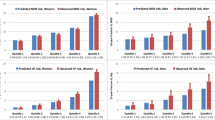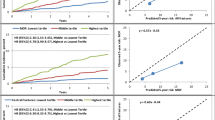Abstract
Diabetes increases fracture and falls risks. We evaluated the performance of the Garvan fracture risk calculator (FRC) in individuals with versus without diabetes. Using the population-based Manitoba bone mineral density (BMD) registry, we identified individuals aged 50–95 years undergoing baseline BMD assessment from 1 September 2012, onwards with diabetes and self-reported falls in the prior 12 months. Five-year Garvan FRC predictions were generated from clinical risk factors, with and without femoral neck BMD. We identified non-traumatic osteoporotic fractures (OF) and hip fractures (HF) from population-based data to 31 March 2018. Fracture risk stratification was assessed from area under the receiver operating characteristic curves (AUROC). Cox regression analysis was performed to examine the effect of diabetes on fractures, adjusted for Garvan FRC predictions. The study population consisted of 2618 women with and 14,064 without diabetes, and 636 and 2201 men with and without the same, respectively. The Garvan FRC provided significant OF and HF risk stratification in women with diabetes, similar to those without diabetes. Analyses of OF in men were limited by smaller numbers; no significant difference was evident by diabetes status. Cox regression showed that OF risk was 23% greater in women with diabetes adjusted for Garvan FRC including BMD (hazard ratio [HR] 1.23, 95% confidence interval [CI] 1.01–1.49), suggesting it slightly underestimated risk; a non-significant increase in diabetes-related HF risk was noted (HR 1.37, 95% CI 0.88–2.15). Garvan FRC shows similar fracture risk stratification in individuals with versus without diabetes, but may underestimate this risk.


Similar content being viewed by others
References
Leslie WD, Rubin MR, Schwartz AV, Kanis JA (2012) Type 2 diabetes and bone. J Bone Miner Res 27(11):2231–2237. https://doi.org/10.1002/jbmr.1759
Janghorbani M, Van Dam RM, Willett WC, Hu FB (2007) Systematic review of type 1 and type 2 diabetes mellitus and risk of fracture. Am J Epidemiol 166(5):495–505. https://doi.org/10.1093/aje/kwm106
Vestergaard P (2007) Discrepancies in bone mineral density and fracture risk in patients with type 1 and type 2 diabetes—a meta-analysis. Osteoporos Int 18(4):427–444. https://doi.org/10.1007/s00198-006-0253-4
Kanis JA, Harvey NC, Cooper C, Johansson H, Oden A, McCloskey EV et al (2016) A systematic review of intervention thresholds based on FRAX: a report prepared for the National Osteoporosis Guideline Group and the International Osteoporosis Foundation. Arch Osteoporos 11(1):25. https://doi.org/10.1007/s11657-016-0278-z
Rubin KH, Friis-Holmberg T, Hermann AP, Abrahamsen B, Brixen K (2013) Risk assessment tools to identify women with increased risk of osteoporotic fracture: complexity or simplicity? A systematic review. J Bone Miner Res 28(8):1701–1717. https://doi.org/10.1002/jbmr.1956
Beaudoin C, Moore L, Gagne M, Bessette L, Ste-Marie LG, Brown JP et al (2019) Performance of predictive tools to identify individuals at risk of non-traumatic fracture: a systematic review, meta-analysis, and meta-regression. Osteoporos Int 30(4):721–740. https://doi.org/10.1007/s00198-019-04919-6
Nguyen ND, Frost SA, Center JR, Eisman JA, Nguyen TV (2008) Development of prognostic nomograms for individualizing 5-year and 10-year fracture risks. Osteoporos Int 19(10):1431–1444. https://doi.org/10.1007/s00198-008-0588-0
Nguyen ND, Frost SA, Center JR, Eisman JA, Nguyen TV (2007) Development of a nomogram for individualizing hip fracture risk in men and women. Osteoporos Int 18(8):1109–1117. https://doi.org/10.1007/s00198-007-0362-8
Giangregorio LM, Leslie WD, Lix LM, Johansson H, Oden A, McCloskey E et al (2012) FRAX underestimates fracture risk in patients with diabetes. J Bone Miner Res 27(2):301–308. https://doi.org/10.1002/jbmr.556
Carnevale V, Morano S, Fontana A, Annese MA, Fallarino M, Filardi T et al (2014) Assessment of fracture risk by the FRAX algorithm in men and women with and without type 2 diabetes mellitus: a cross-sectional study. Diabetes Metab Res Rev 30(4):313–322. https://doi.org/10.1002/dmrr.2497
Bhattoa HP, Onyeka U, Kalina E, Balogh A, Paragh G, Antal-Szalmas P et al (2013) Bone metabolism and the 10-year probability of hip fracture and a major osteoporotic fracture using the country-specific FRAX algorithm in men over 50 years of age with type 2 diabetes mellitus: a case-control study. Clin Rheumatol 32(8):1161–1167. https://doi.org/10.1007/s10067-013-2254-y
Blanchard JF, Ludwig S, Wajda A, Dean H, Anderson K, Kendall O et al (1996) Incidence and prevalence of diabetes in Manitoba, 1986–1991. Diabetes Care 19(8):807–811. https://doi.org/10.2337/diacare.19.8.807
Lix L, Yogendran M, Shaw S, Burchill C, Metge C, Bond R (2008) Population-based data sources for chronic disease surveillance. Chronic Dis Can 29(1):31–38. https://doi.org/10.24095/hpcdp.29.1.04
Lix LM, Azimaee M, Osman BA, Caetano P, Morin S, Metge C et al (2012) Osteoporosis-related fracture case definitions for population-based administrative data. BMC Public Health 12:301. https://doi.org/10.1186/1471-2458-12-301
Leslie WD, Morin SN, Lix LM, Niraula S, McCloskey EV, Johansson H et al (2019) Performance of FRAX in women with breast cancer initiating aromatase inhibitor therapy: a registry-based cohort study. J Bone Miner Res 34(8):1428–1435. https://doi.org/10.1002/jbmr.3726
Peschken CA, Hitchon CA, Garland A, Bernstein CN, Chen H, Fransoo R et al (2016) A population-based study of intensive care unit admissions in rheumatoid arthritis. J Rheumatol 43(1):26–33. https://doi.org/10.3899/jrheum.150312
Yang S, Leslie WD, Yan L, Walld R, Roos LL, Morin SN et al (2016) Objectively verified parental hip fracture is an independent risk factor for fracture: a linkage analysis of 478,792 parents and 261,705 offspring. J Bone Miner Res 31(9):1753–1759. https://doi.org/10.1002/jbmr.2849
O’Donnell S (2013) Use of administrative data for national surveillance of osteoporosis and related fractures in Canada: results from a feasibility study. Arch Osteoporos 8:143. https://doi.org/10.1007/s11657-013-0143-2
Leslie WD, Epp R, Morin SN, Lix LM (2021) Assessment of site-specific X-ray procedure codes for fracture ascertainment: a registry-based cohort study. Arch Osteoporos 16(1):107. https://doi.org/10.1007/s11657-021-00980-z
Hanley JA, McNeil BJ (1983) A method of comparing the areas under receiver operating characteristic curves derived from the same cases. Radiology 148(3):839–843. https://doi.org/10.1148/radiology.148.3.6878708
Agarwal A, Leslie WD, Nguyen TV, Morin SN, Lix LM, Eisman JA (2021) Predictive performance of the Garvan fracture risk calculator: a registry-based cohort study. Osteoporos Int. https://doi.org/10.1007/s00198-021-06252-3
Schwartz AV, Vittinghoff E, Bauer DC, Hillier TA, Strotmeyer ES, Ensrud KE et al (2011) Association of BMD and FRAX score with risk of fracture in older adults with type 2 diabetes. JAMA 305(21):2184–2192
Leslie WD, Caetano PA, Macwilliam LR, Finlayson GS (2005) Construction and validation of a population-based bone densitometry database. J Clin Densitom 8(1):25–30. https://doi.org/10.1385/jcd:8:1:025
Leslie WD, Nguyen TV, Morin SN, Lix LM, Eisman JA (2020) Independent performance evaluation of the Garvan fracture risk calculator: a registry-based cohort study. Wiley, Hoboken
Shah VN, Shah CS, Snell-Bergeon JK (2015) Type 1 diabetes and risk of fracture: meta-analysis and review of the literature. Diabet Med 32(9):1134–1142. https://doi.org/10.1111/dme.12734
Fan Y, Wei F, Lang Y, Liu Y (2016) Diabetes mellitus and risk of hip fractures: a meta-analysis. Osteoporos Int 27(1):219–228
Acknowledgements
The authors acknowledge the Manitoba Centre for Health Policy for use of data contained in the Population Health Research Data Repository (HIPC 2016/2017-29). The results and conclusions are those of the authors and no official endorsement by the Manitoba Centre for Health Policy, Manitoba Health, Seniors and Active Living, or other data providers is intended or should be inferred. This article has been reviewed and approved by the members of the Manitoba Bone Density Program Committee. SNM is chercheur-boursier des Fonds de Recherche du Québec en Santé. LML is supported by a Tier I Canada Research Chair. TVN is supported by an Australian National Health and Medical Research Council Investigator Grant APP1195305.
Funding
No funding support was received for this research.
Author information
Authors and Affiliations
Contributions
AA and WDL involved in conception, design, analysis, and drafting the article; all authors involved in interpretation of the data and critically revising the article for important intellectual content, final approval of the version to be published and agreement to be accountable for all aspects of the work. WDL had full access to all the data in the study and took the responsibility for the integrity of the data and the accuracy of the data analysis.
Corresponding author
Ethics declarations
Conflict of interest
AA Agarwal, WD Leslie, LM Lix and SN Morin declare they have no conflict of interest. JA Eisman has consulted for and/or received research funding from Amgen, deCode, Merck Sharp and Dohme, and Sanofi-Aventis. TV Nguyen has received research funding from Amgen and honoraria for consulting and symposia from Merck Sharp and Dohme, Roche, Servier, Sanofi-Aventis and Novartis.
Human and Animal Rights
All procedures were in accordance with the ethical standards of the responsible committee on human experimentation (institutional and national) and with the Helsinki Declaration.
Informed Consent
Informed consent was waived in accordance with provisions in the Manitoba Personal Health Information Act (PHIA) for approved research involving deidentified data.
Additional information
Publisher's Note
Springer Nature remains neutral with regard to jurisdictional claims in published maps and institutional affiliations.
Rights and permissions
About this article
Cite this article
Agarwal, A., Leslie, W.D., Nguyen, T.V. et al. Performance of the Garvan Fracture Risk Calculator in Individuals with Diabetes: A Registry-Based Cohort Study. Calcif Tissue Int 110, 658–665 (2022). https://doi.org/10.1007/s00223-021-00941-1
Received:
Accepted:
Published:
Issue Date:
DOI: https://doi.org/10.1007/s00223-021-00941-1




